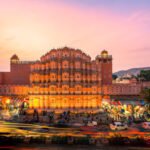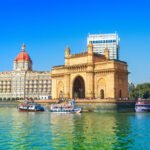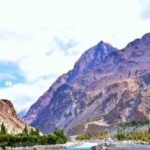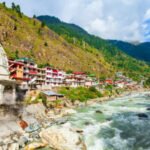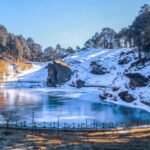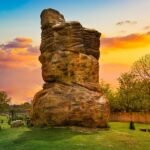Neelkanth Mahadev Lahaul and Spiti Best Trek 2025
Neelkanth Mahadev Lahaul and Spiti, Himachal Pradesh: Neelkanth Mahadev refers to two things: a peak in the Himalayas named after the god Shiva, and the lake situated at its base.
- Neelkanth Mahadev Peak: is a high peak in the Lahaul region of Himachal Pradesh, India. It is named after Neelkanth, another name for Shiva, which means “blue-throated.” Legend has it that this is the spot where Lord Shiva swallowed the poison that emerged from the churning of the cosmic ocean.

- Neelkanth Mahadev Lake: is a small, high-altitude lake located at the foot of the Neelkanth Mahadev peak. The lake is considered sacred by Hindus and is believed to have healing properties. The trek to the lake is a popular one among pilgrims and adventure seekers.

The Neelkanth Mahadev Trek in Lahaul is a hidden gem located deep within the magnificent Lahaul region of Himachal Pradesh, India. The trek leads to an emerald green alpine lake, believed to be the abode of Lord Shiva. Legend has it that this is the spot where Lord Neelkanth underwent Tapasya, an austere deep meditation to control one’s mind, speech, thoughts, and bodily desires.
The trek is a moderate one, with breathtaking valley views, mountain panoramas, and a stunning high-altitude lake as its reward. The total trek length is around 15 kilometers one way, with an altitude gain of about 2800 meters. The trek typically takes 3 days and 2 nights to complete.
Here are some of the highlights of the Neelkanth Mahadev Trek:
- Remote and Unspoiled Beauty: The Neelkanth Mahadev Lake trek is one of the most untouched treks in Himachal Pradesh. The trail winds through beautiful meadows, glaciers, and serene landscapes offering a true escape from the hustle and bustle of everyday life.
- Religious Significance: The trek has religious significance for Hindus, as the lake is believed to be sacred. A small temple dedicated to Lord Shiva is located near the lake.
- Exhilarating Water Crossings: The trek involves multiple river crossings, adding an element of adventure to the journey.
- Diverse Flora and Fauna: The trek offers opportunities to spot a variety of flora and fauna, including birds like Himalayan Griffons, Lammergeyers, and Snowcocks, and animals like Red Foxes and Himalayan marmots.
Things to keep in mind before planning the trek:
- Best Time to Visit: The ideal time to embark on the Neelkanth Mahadev Trek is from mid-June to mid-September. During this period, the weather is pleasant, with clear skies and comfortable temperatures.
- Difficulty Level: While the trek is rated moderate, it’s important to be in good physical condition due to the high altitude. Acclimatization is important to avoid altitude sickness.
- Permits: Permits are required to undertake the trek. These can be obtained from the local authorities in Lahaul.
- Guided vs. Independent Trek: Given the high altitude and relatively unmarked trails, it’s advisable to consider trekking with a registered guide or trekking company, especially for first-timers.
- Religious Significance:
- According to legend, the peak near the lake is known as Neelkanth Kailash, and the lake itself is believed to have healing properties.
- Many devotees undertake this trek to bathe in the holy water of the lake.
Here’s a breakdown of the trek:
- Overview:
- Considered a moderate difficulty trek.
- Distance: 15 kilometers one way (30 kilometers round trip)
- Altitude: 4,200 meters (13,777 feet)
- Duration: 3 days and 2 nights
- Best time to visit: Mid-June to mid-September.
- The Trek:
- The trek starts from the small hamlet of Nainghar and takes you through varied terrain, including meadows, moraine fields, and rocky slopes.
- En route, you’ll encounter several water crossings, adding an element of adventure to the journey.
- The highlight of the trek is the Neelkanth Mahadev Lake, a beautiful emerald green lake surrounded by snow-capped peaks.
- There’s a small temple dedicated to Lord Shiva near the lake, where pilgrims can pay their respects.
- Highlights:
- Breathtaking scenery of the Lahaul Valley.
- Panoramic views of the Himalayan mountains.
- Pristine Neelkanth Mahadev Lake with its turquoise waters.
- A small temple dedicated to Lord Shiva near the lake.
- Varied terrain with meadows, streams, and moraine trails.
- Things to Consider:
- The trek can be strenuous at times, especially due to the high altitude. Proper acclimatization is necessary.
- The weather in the Himalayas can be unpredictable. Be prepared for cold temperatures, strong winds, and sudden rain or snowfall.
- Since the region is remote, there are limited facilities available. Proper planning and packing are essential.
- Read Also…
What is Neelkanth Mahadev?
Neelkanth Mahadev refers to two things:
Neelkanth Peak: A high peak in the Himalayas associated with Lord Shiva.
Neelkanth Mahadev Lake: A sacred lake located at the foot of the peak, believed to be the abode of Lord Shiva.
Where is Neelkanth Mahadev?
Neelkanth Mahadev is located in the Lahaul region of Himachal Pradesh, India, bordering Spiti.
Is there a trek to Neelkanth Mahadev Lake?
Yes, there is a trek to Neelkanth Mahadev Lake. It’s a moderate to challenging trek with stunning scenery. The total trek length is around 15 kilometers one way, with an altitude of 4200 meters (13,777 ft) at the lake.
What are some things to know about the trek?
The trek is considered relatively untouched and less crowded compared to other treks in Himachal Pradesh.
The best time to visit is usually between mid-June to mid-September.
The trek involves multiple water crossings and requires proper planning and equipment for high-altitude trekking.
Local legends say women are not allowed to visit the lake, but it’s advisable to check with local authorities for current customs.










